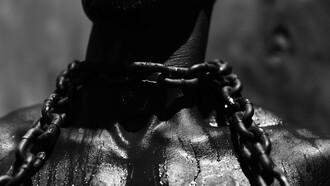Chinese calligraphy, (Chin. 書法 shū faˇ), contains the essence of Chinese culture. Calligraphy is one of four noble arts in China. It is a connective dimension where the Chinese language, history, philosophy, and aesthetics merge. Shufa’s literal translation “the way of writing” expresses the very root of the art; close bonds with Chinese written signs, on the one hand, and painting, on the other. It is a known art for the cultivation of the mind, which is one of the most distinctive features of Chinese culture.
Traditional use of calligraphy
In Chinese culture it is not accounted the origin of speech, but the attention has always been on writing. Chinese historians consider that the creation of language means the creation of Chinese characters.
Chinese believe that Cang Jie invented writing 4000 years ago. The ancient Chinese believed that Heaven had secret codes, and only those with divine powers were granted with the ability to decode it. Cang Jie, who had four eyes, the ability to interpret natural signs and to transcribe the shapes of natural objects into writing.
Legend says when Cang Jie created Chinese written symbols, spirits howled in agony as the secrets of Heaven were revealed. Since then all Chinese share a great veneration for written symbols. Traditionally Chinese have great respect for the written word as unites Chinese people with different, often unintelligible dialects. Chinese civilization was the first to invent a movable type of printing around 1041 CE.
Chinese characters contain a pictographic representation of the pictures, which is much more than a useful tool for communication, but an endless world of symbols with particular rules. During historical evolution, Chinese characters have been inscribed, incised or written into turtle shells, pottery, different types of stones, bamboo, silk, and finally on the sheets of the very first paper.
Chinese characters are an important part of ancestral worship tablets and fortuneteller’s cards, and are more than decoration on doors for good luck, but a tool to send away evil spirits. During festivals, brush-written couplets are on public display. Most of the couplets contain characters such as: good fortune/blessings (chin. 福 fú) and, longevity (Chin. 壽 shòu). Before China witnessed the usage of hard pens and pencils, the brush was the only writing tool. Brush writing was a skill every educated man had to master. Since the seventh century, in China was introduced the imperial civil service examinations. It had the role to determine most suited one’s to enter the government’s bureaucracy. Calligraphy was an important testing subject, and a tool for how to test knowledge in other subject areas. The testing system granted people with talent and abilities to have progressed in society.
As calligraphy became a very important subject, and matter of talent, from a very early age, students would start learning calligraphy and Confucianism. At the beginning of 20th century, the civil service examinations were abolished, but still in China good handwriting is extremely valued.
Traditionally in China, learning skills, handwriting mastery, and an official post were hand to hand combination. Most of China’s rulers were masters of calligraphy, with outstanding talents and calligraphy creations. For instance, Song dynasty Emperor Huizong (1082–1135) created his own style called “Slender Gold”.
Calligraphy in contemporary China
In China calligraphy is a fine art which surpasses painting, sculpture, ceramics, poetry and influences every aspect of Chinese life. Person’s handwriting skills reveal proper education, self-discipline and character, and generally someone's personality.
Chinese calligraphy represents and reveals someone's character and mentality, therefore, excellent handwriting gives satisfaction and respect. Calligraphy is performed by people of all ages and backgrounds. In contemporary China, calligraphy is more than a hobby. It is a way of life!
Calligraphy influences every pore of Chinese society. Calligraphy has national competitions, national organizations, magazines, etc.
It exists a very popular form of Qi Gong meditation called “ground calligraphy”. Usually in the early morning people gather in parks, and bring a special brush tied to a stick and a bucket of water. Most of the time people wield gigantic brushes on the pavement practicing water calligraphy. The Chinese art of calligraphy has also spread to nearby countries such as Japan and Korea, where it is practiced and studied with great enthusiasm.
Chinese characters characteristics
Chinese characters are formed by assembling dots and lines, with more variety in shapes. Each element is a building block of Chinese characters, called a stroke. In writing, various strokes and shapes are assembled in a two-dimensional space, first into components, and combining components into characters.
As example, the Chinese character 字 zì (word) has two components, 宀 and 子, arranged in an up-down constellation. The compone宀 consists of three strokes, as does the other component 子. It is considered for reading newspapers it is required knowledge of between three to four thousand Chinese characters. Each Chinese character has a unique structure. Character components can be arranged in a top to bottom, left to right, or more complex configuration.
In calligraphy, the soft and resilient writing brush is used to vary the shape and thickness of each stroke. This tool, combined with ink on absorbent paper, makes each character unique.
Chinese calligraphers make great effort to keep characters in a text different from one another, where variation is the key.
Personal expression of emotions is the ability to reach the ultimate goal of the nature of Chinese writing, and depends on the writing instruments, and the calligrapher’s skills. An important feature of calligraphy is to cultivate our creative nature.
It is a known fact that Chinese calligraphy requires and activates a balanced use of both sides of hemispheres of the brain. When studying calligraphy we learn to use eyes in order to observe and analyze the details of structural writing as an art, and as a complete form. The purpose of calligraphy education is to exploit, upgrade and develop human potential.
The four treasures
Chinese calligraphy is a unique art with proper tools such as: brush pen (Chin. bĭ筆), ink (Chin. mò 墨), paper (Chin. zhĭ 紙), and ink stone (Chin. yàn 硯).
The brush
By legend, the Qin dynasty general Meng Tian (ca. 200 BCE) is believed to be the founder of the writing brush. However, science unearthed red and black brush strokes on the oracle bones from the time of Shang dynasty (1700. BCE–1100. BCE), and we learned how old usage of brushes exists. The oldest brush to be found dates back to the Warring States period (475–221 BCE), from the Hunan province.
For calligraphy, the brush has the most important role, and its techniques are known as brushwork. The most important about brush is its flexibility. The tuft is made of hair from different animals as hair for brushes. Depends on which animal hair is used, the season and from which animal part is taken, creates varying degrees of firmness and softness, as the quality of the brush.
Generally speaking soft-hair brushes are more difficult to control, therefore they are recommended not for beginners. They are used for writing large characters as they hold more ink. To write small characters usually is used weasel hair, as it's just a bit elastic, stiff and resilient and does not hold a large amount of ink.
Mixed hair is the most usable for several different tasks. Depend on the size, and variety of the characters to be written, we use different sizes of the brush. To make handle, mostly is used bamboo, it could be carved by written characters into the seal, but also can be applied different materials, such as: gold, silver, etc.
Nowadays the best brushes are considered to be “Hu brushes” (Chin. 湖筆Hú bıˇ), made in Huzhou of Zhejiang Province. New brushes are softly glued by tuft together to prevent damage during shipping. As a general rule, before using a new brush we must soak the tuft in lukewarm water for half an hour, and afterward rinse out the glue and gently loosen the bristles.
Special attention is to be made before writing. Be certain not to have loose hair, as will destroy the stroke perfection and appearance. When finish writing, it is mandatory to rinse out the ink under a cold tap.















